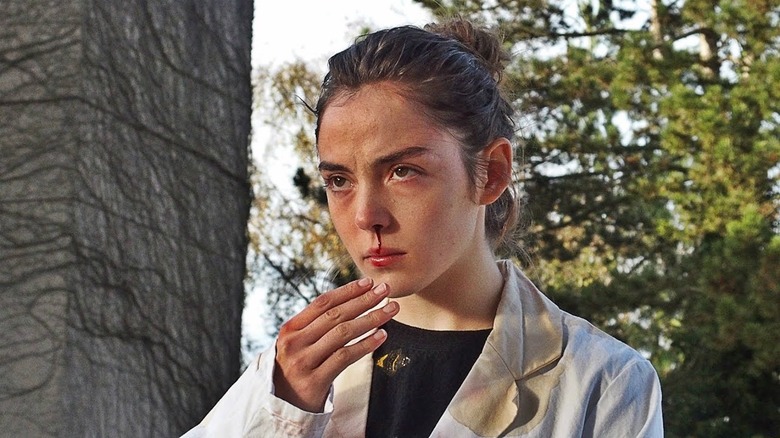
There is perhaps no greater honor a horror filmmaker can receive than to hear that their film made audiences physically ill. The genre of horror, after all, seeks to engage with the audience's fear and anxiety, allowing audiences to explore their darker emotional spaces while in the safety of a movie theater. The most successful movies have the capacity to leave a viewer feeling wary and uncertain about the world around them, and, in the below cases, leave them feeling physically sick. Throughout horror history, multiple films have garnered -- often unsubstantiated -- legends about how they caused audiences to faint, to vomit, to riot, to go insane, or to die from fright.
Often filmmakers will lean into these legends, and some might even playfully invent so-terrifying-you'll-die urban legends to come pre-packed with an unopened film. Other filmmakers are taken to court over their terrifying movies. Some movies have been outright banned because of their alleged illness-inducing powers. No matter the circumstances, a story about how a film is so scary that it will make you vomit stand to my ear as a glowing recommendation.
Freaks (1932)
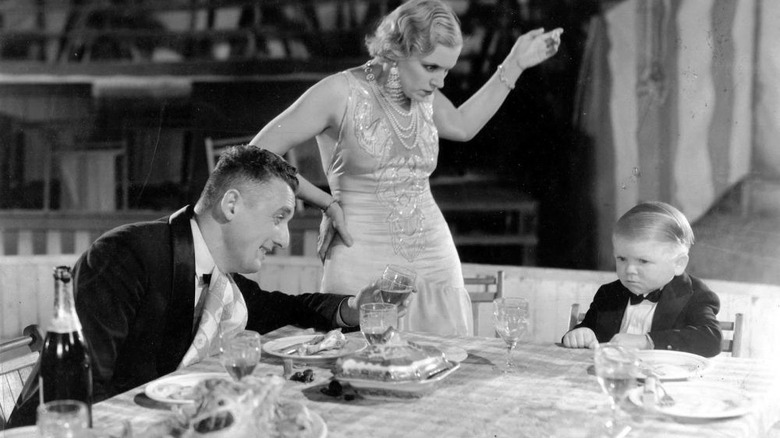
After the success of "Dracula" in 1931, director Tod Browning was granted leeway to pursue a passion project he had longed dreamed about. Browning was always enamored of carnivals and traveling circuses and, at age 16, ran away from home to work in one. Yes, people did indeed run away and join the circus. For several years, he worked as a barker, a contortionist, and a even performed a live burial act wherein he billed himself as The Living Hypnotic Corpse. Wanting to pay honor to circus workers in film -- in particular, the sideshow performers -- Browning made the feature film "Freaks" in 1932, which starred a cast of real circus employees who were featured in the institution's notorious "freak shows." Stories go that MGM employees were unnerved by non-able-bodied actors visiting the studio lot that some of them, notably Daisy and Violet Hilton, had to rest inside tents, out of the public eye. It was this sort of unfair prejudice that Browning was seeking to combat by making "Freaks."
The controversy continued into the film's release, and audiences were unready for a mainstream melodrama about the lives of circus sideshow performers. The main story of "Freaks" involves the wealthy German lord Hans (Harry Earles) who is seduced by, and marries, the circus' trapeze artist Cleopatra (Olga Baclanova), who intends to poison him and take his substantial inheritance. This is understandingly upsetting for Hans' first wife Frieda (Daisy Earles), and Cleopatra's plan soon leaks its way out to the rest of the circus performers who, late in the film -- in a scene that was mandated by the studio -- attack Cleopatra with knives. The final scene reveals that Cleopatra has been transformed into a bizarre chicken woman and is now on display as part of the circus sideshow she dared to disrespect.
Anyone who has seen "The Elephant Man" likely knows circus sideshow's exaggerations as to how a "freak" received their unusual proportions -- in "The Elephant Man," John Merrick's mother was terrified by elephants while pregnant -- and the movie "Freaks" received an equally exaggerated legend about how the film was so terrifying, and the people in it so unusual, that a young mother watching the movie miscarried her pregnancy. I was unable to find evidence of this, but the legend persists.
Macabre (1958)
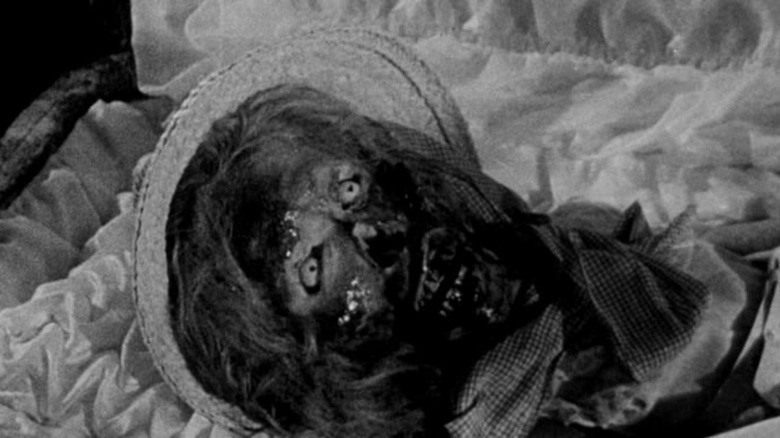
"Macabre" was director William Castle's 40th feature film, but really, it was his first. Castle, perhaps the greatest American showman since P.T. Barnum, began branching out into horror movies in the late 1950s after a long career of studio-mandated westerns and other genre cheapies. By that point in his career, Castle -- always interested in gore and horror -- understood that in order to sell a movie to a young, hungry audience, one must have an angle. A gimmick, if you will.
Castle, tapping into a very general paranoia about extreme horror films killing their audience members, openly proclaimed in the advertising for "Macabre" that there was a very real possibility you may die of fright. If true, this would have been a headache from an insurance standpoint, so Castle acted accordingly. Upon arrival at the theater, audience members were handed a certificate for a life insurance policy, backed by Lloyd's of London, that would award the viewer $1,000 (close to $9,700 in 2022) should they die of fright in the theater. Additionally, Castle hired "nurses" to be on standby in theater lobbies to check on the health of anyone who might be close to death due to "Macabre's" intense scenes.
"Macabre," by the way, is merely a fun potboiler that features a kidnapped child, and someone being sealed inside a coffin alive. While possessed of an EC Comics-like wickedness, there is nothing so horrifying as to scare you to death. Nonetheless -- and one can posit that this was to attract the attention of the pretty actresses hired to play the nurses -- there are a few stories of young men "fainting" in the theater because "Macabre" was just that scary. Regardless, the gimmick was a hit, "Macabre" made millions, and Castle made several of the best horror movies of all time with even more elaborate gimmicks in the future.
The Exorcist (1973)
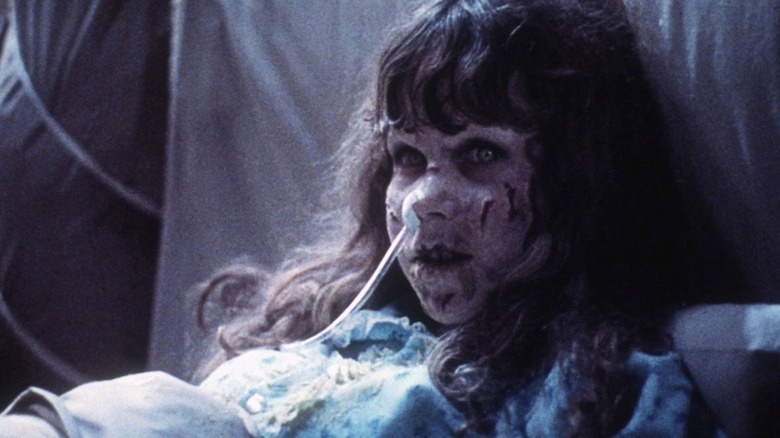
Often called the scariest film of all time, and -- until 2017 with the release of "It: Chapter One" -- the highest-grossing horror film in history, William Friedkin's "The Exorcist" has no shortage of legends. Not only are the film's "curses" part of public record -- and were even covered in the debut episode of Shudder's "Cursed Films" documentary series -- but audience reaction to "The Exorcist" was intense and dramatic. Stories persist to this day that certain moments in "The Exorcist" cause audience members to faint.
The most notorious scene -- and the one that has the legends attached to it -- involves the 12-year-old Regan McNeill (Linda Blair) doing something horrible with a crucifix. This is a scene that was also featured in the William Peter Blatty novel on which the film was based. Without getting explicit, the film's special gore effect was achieved by Blair stabbing a crucifix into a sponge that was soaked with fake blood. It was this scene that allegedly inspired the legendary fits of unconsciousness. Add to that scene any number of horrifying images -- vomit, heads turning backward, eerie voices, levitation -- and you have a pretty damned scary movie, my friend.
Irreversible (2002)
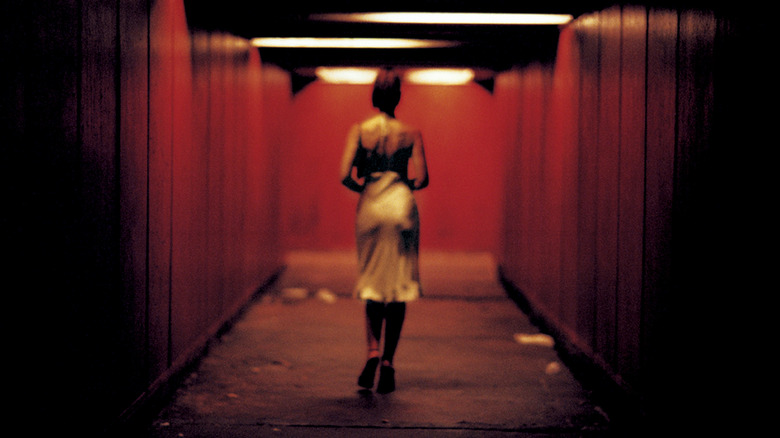
Notoriously walked out on at Cannes, and often considered one of the most disturbing feature films ever made, Gaspar Noé's "Irreversible" sought out to make audiences sick. With a message of "Time Destroys Everything," and told in reverse scene order, "Irreversible" is one of the most aggressive, and perhaps one of the more pessimistic movies ever made. It also contains a notorious sexual assault scene wherein Monica Bellucci (who directed the scene herself) is attacked in an underground passage. The scene is an unbroken, nine-minute shot. It's difficult to watch.
Not content to merely shock audiences with an extended scene of extreme sexual violence, Noé also used an experimental sound technique during the film's early scenes, employing ultra low-frequency bass notes that had previously been developed as a non-lethal weapon intended for use on the battlefields of World War II. Certain low sounds have been known to induce nausea, and Noé wanted his audience to feel that nausea. Add to that a severe beating in a club, loud music, and flashing strobe effects, and you have a vomiting audience just waiting to happen. Mercifully, the film's violence is relegated to its first half, and the falling action lets audiences recover.
Nonetheless, the horror of the opening scenes lingered with audiences, and left many feeling physically ill, leading some to flee the theater, struck by fits of queasiness. If the goal of the film, however, was to leave people feeling ill, then "Irreversible" was a rousing success.
Taxidermia (2006)
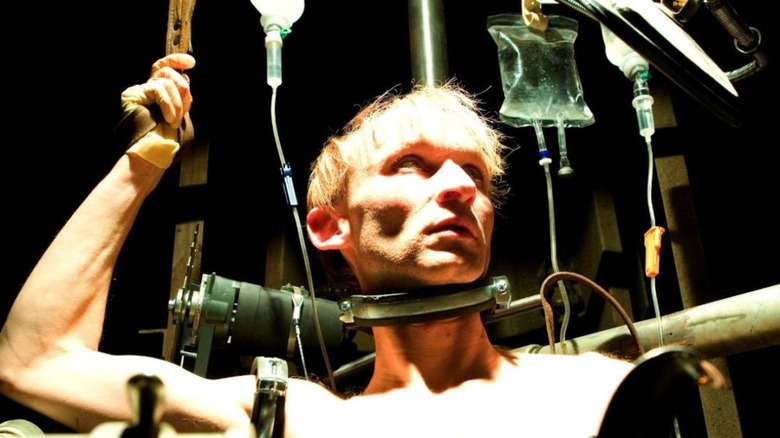
Hungarian filmmaker György Pálfi's 2006 film "Taxidermia" is a difficult one to stomach. Presented in vignettes, the film follows several generations of men as they face the darkest appetites of their bodies. This involves trauma to sensitive areas, violating a pig corpse, a great deal of overeating, and a climax wherein a character uses an elaborate machine to remove their own internal organs. Partly a meditation on the nature of our relationships to our physical forms, and partly a grand guignol horror oddity, no one will leave "Taxidermia" without several disturbing images burned into their brains.
There are plenty of dark and gross moments to choose from, so it's difficult to say which moment in particular inspired the most vomiting, but vomit audience members did. Anecdotally, as someone who worked in a movie theater where "Taxidermia" played in 2006, audiences had to step out during the competitive eating scenes, wherein two of the main characters hastily shove large quantities of gelatinous meatlike substances into their mouths. The film also experienced walkouts during the final self-taxidermy scenes, as there are numerous closeups of actual, pulsating organs. It is unclear how Pálfi achieved these effects.
I have heard more dry heaves during "Taxidermia" than in any other movie, unless you count my own for the latest "Space Jam" film.
Antichrist (2009)
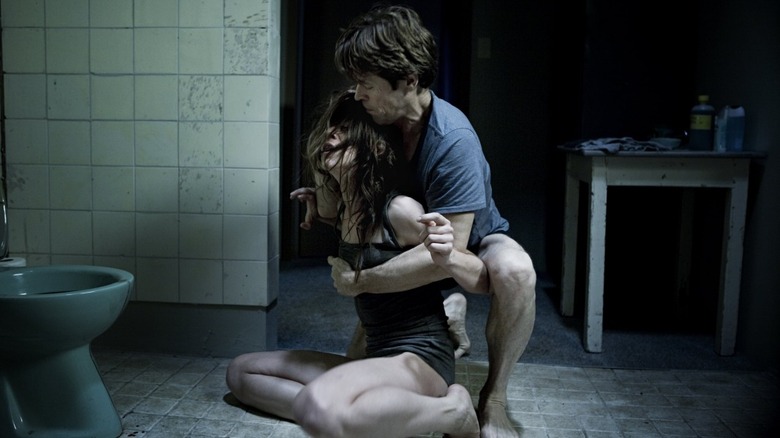
Lars Von Trier's 2009 film "Antichrist" is the first part of what has come to be called the Depression Trilogy, which also includes 2011's "Melancholia," and 2013's "Nymphomaniac." All three films delve into the intimate details of the depressed mind, exploring the unusual connections our brains manifest when soaked in sadness and mourning. Sex and death become interlinked. The natural world become dank and forbidding. And our relationships to others become hateful and suspect. The invading force of depression often lies, convincing you that you have no self worth. Lars Von Trier struggled with severe, suicidal depression for many years, and he was uncompromising when he put his own emotional state on camera in "Antichrist," using actress Charlotte Gainsbourg as his mouthpiece, and Willem Dafoe as the obnoxious male who insists on analyzing away something that is too overwhelming to be analyze.
"Antichrist" is about a wife and a husband who recently lost their young child to an unfortunate accident while they were having sex in the shower. The sadness and mourning following the event leads to a retreat to a remote cabin in the woods -- as scary as anything from an "Evil Dead" movie -- to heal. They do not heal. Indeed, madness begins to infect them both, and the film climaxes with Gainsbourg attacking Dafoe, inflicting some horrid genital trauma, and screwing a lodestone through his leg. There is a also a closeup of ... a particular act ... look, it's a disturbing film.
Another piece of anecdotal evidence: At least one person I watched this film with left the theater to take a few deep breaths in the bathroom. Another did indeed vomit a bit, although they had been drinking a bit. It will take a strong constitution to see "Antichrist," but the film will reward you with an accurate portrait of what it feels like to be depressed.
Raw (2016)
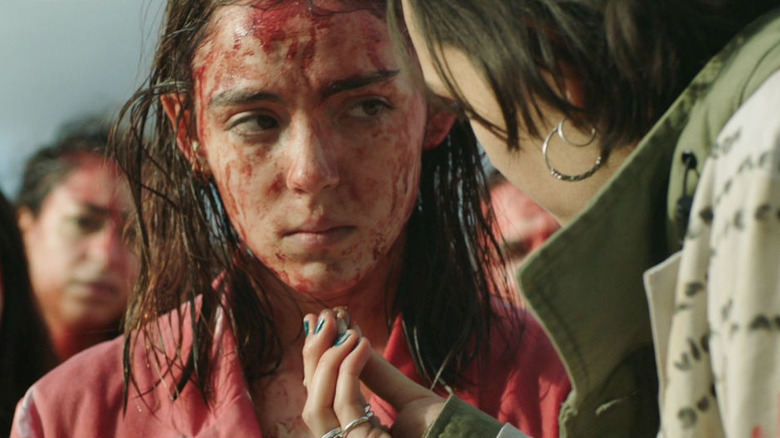
When it debuted at TIFF, Julia Ducournau's "Raw" inspired calls to the paramedics. Reports from the venue said that several audience members had passed out during the screening. Given the film's cannibalistic subject matter, it's easy to see why. "Raw," true to its title, features a lot of chewing on uncooked meats and, in several notable sequences, human meat that's still alive. There are bite marks, lacerated legs, and a scene where a human finger, uh, cannot be retrieved. Additionally, there is a scene in "Raw" where a real horse is actually anaesthetized on camera which only added to the fleshy authenticity of the film. Don't worry. The horse was okay.
Ducournau, with "Raw" and her latest film "Titane," appears to have an emerging thesis in her body of work about our human flesh chassis and our slavery to it. We are our bodies, and our appetites rule us. That the cannibalism in "Raw" was presented so frankly may have a lot to do with the reaction it got at TIFF. This was no wicked game or exploitation movie. This was a movie that was confronting audiences about their very pumping humors, and it's to Ducourneau's credit that she was so effectively able to, uh, get under everyone's skin.
Antrum: The Deadliest Film Ever Made (2018)
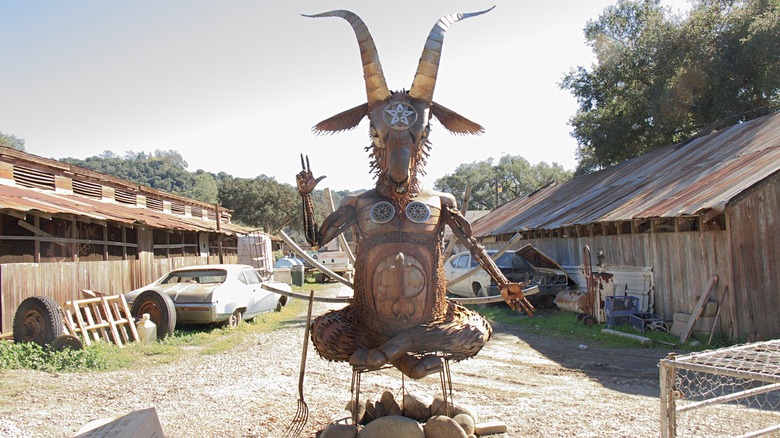
While the above films made people sick, the 2018 Canadian mockumentary "Antrum: The Deadliest Film Ever Made" is the only one that claims it will kill you right in the title. Perhaps taking inspiration from John Carpenter's films "In the Mouth of Madness" and his "Masters of Horror" episode "Cigarette Burns" -- both of which featured fictional films that caused viewers to go mad -- "Antrum" is a movie about a fictional movie that has a 100% fatality rate among its viewers. Staged in BBC documentary style, it involves a lot of convincing period detail, as it unfolds the style of a mad European filmmaker in the 1970s whose film was infected with a curse. Think "The Ring" via "Cannibal Holocaust."
ANTRUM IS NOT SAFE, a disclaimer at the head of the film declares.
As far as I have been able to discern, no viewers of "Antrum" have actually died after watching it. Any claim, however, that a film is so scary it might kill me is certainly going to attract my attention. After all, what better way for a cinephile to go out than to be killed by a film. Let's make some popcorn and watch the film that will scare us to death.
Read this next: Horror Movies That Even Horror Fans Could Hardly Finish
The post Horror Movies That Made Audiences Physically Sick appeared first on /Film.
from /Film https://ift.tt/AK6XUHQ
